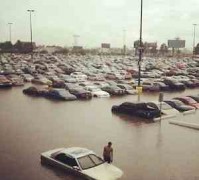
Storms continue to pound Las Vegas
Storms continue to pound Las Vegas
Although it doesn’t rain in Las Vegas too often, when it does rain, it literally pours and creates numerous unsafe weather conditions as storms continue to pound Las Vegas.
The inclement weather began on Wednesday and is expected to continue through Friday.
The National Weather Service has issued a flash flood warning and have noted that as of Thursday evening, rainfall rates of 2 to 3 inches per hour have been reported in parts of Las Vegas.
Since Las Vegas is typically so dry, when there is heavy rainfall, many residents are not prepared for the adverse driving conditions. This coupled with the fact that the roads become extreme slippery can be a recipe for disaster.
Numerous accidents have already occurred across the Las Vegas Valley and residents are being warned to use extreme caution.
The most important this to remember is NEVER drive across or walk through moving waters.
You don’t know how deep the water is or realize how just how quickly the water can carry a person away.
Each time there is a heavy rainfall, we hear about tragic deaths, cars stuck across the valley because people drove through moving waters and even people having to be rescued.
Although Flash Flood season is between July and September, the current storm proves that severe weather conditions can occur anytime.
As the storms continue to pound Las Vegas, being familiar with flood safety tips is important. Some of the tips culled form the Regional Flood District website include;
• If you are driving and are caught in a major storm, consider pulling over to a location higher than the street and wait out the storm. Intense summer storms in Southern Nevada are usually over in a couple of hours.
• Never drive through a flooded roadway or around barricades. Roads underneath may be damaged and impassable.
• If your car stalls, it may be safer to stay with the vehicle. Swift moving water only inches deep can sweep you off your feet and result in drowning. Only you can make the decision of which option is safer.
• The majority of flood-related deaths are caused by people attempting to drive through moving water. Swift moving floodwater can sweep away cars. Larger vehicles, such as trucks and SUVs, may be more likely to float because large tires increase the buoyancy of the vehicle.
• Be especially cautious at night when it is harder to recognize the dangers of flash floods, such as the depth and speed of the water.
You can visit the Regional Flood District website to see all the 2012 flood safety tips.
Related articles







 Follow
Follow

